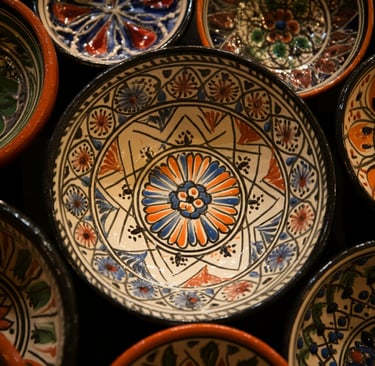Andalusian Art's Influence on Moroccan Pottery Legacy
INFLUENCES & INSPIRATIONS


Moroccan pottery is renowned globally for its elaborate patterns, distinctive aesthetics, and cultural importance. The craftsmanship inherent in Moroccan ceramics tells tales of a profound history that spans generations. One of the most significant influences on this skill is Andalusian art. The amalgamation of Andalusian and Moroccan cultures, particularly during the era of Muslim Spain, significantly influenced all facets of Moroccan society, including its pottery heritage. This article examines the impact of Andalusian art on Moroccan ceramics, highlighting how this cultural interchange fostered a distinctive and enduring creative heritage.
Historical Context of Andalusian Influence
To fully understand the impact of Andalusian art on Moroccan ceramics, it is critical to grasp the historical connection between the two places. From the 8th to the 15th century, a prosperous civilization developed in Al-Andalus, present-day Spain, characterized by the coexistence of Muslims, Christians, and Jews in relative concord. The Muslim governance in Spain facilitated progress in science, architecture, art, and handicraft, fostering a vibrant cultural environment that drew intellectuals, artists, and merchants from the Islamic world and beyond.
In 1492, with the fall of Granada, the last Muslim bastion in Spain, several Andalusians sought refuge in Morocco. The refugees carried their creative traditions, methods, and styles with them. The introduction of Andalusian culture to Morocco had a significant impact on Moroccan craftsmanship, particularly pottery. Moroccan artists encountered new methods and aesthetics, which they assimilated and integrated with their rich past, resulting in a development in the design and manufacture of Moroccan ceramics.
Andalusia's Aesthetic and Fundamental Components
The seamless integration of geometric, floral designs and vivid color schemes distinguishes Andalusian art, particularly during its zenith in Al-Andalus. These features originated from Islamic artistic traditions, which prioritized elaborate patterns to express harmony and order alongside the abstract depiction of nature. Andalusian painters, constrained by religious prohibitions on representing live beings in Islamic art, mostly used geometric patterns and stylized natural motifs for their decorations. Andalusian art mirrored the cultural variety of the country, including elements from Byzantine, Visigothic, Roman, and North African traditions. The cross-cultural influences produced a unique style marked by intricate decoration, symmetry, and a profound love for workmanship. When Andalusian artists settled in Morocco, they introduced a sophisticated artistic sense that significantly influenced Moroccan ceramics. The integration of Andalusian aesthetics into Moroccan ceramics resulted in heightened geometric accuracy, the application of vivid glazes, and the inclusion of floral and botanical patterns, which continue to characterize Moroccan pottery today.
The methods and aesthetics that Andalusians introduced to Moroccan pottery
By introducing improved glazing methods, Andalusian art has contributed to Moroccan ceramics. Andalusian artists excelled at lustreware, a pottery style that used metallic glazes on ceramics to create a dazzling look that resembled precious metals. Morocco received this method, modified it, and integrated it into indigenous ceramic traditions. Moroccan artists adopted these glazing techniques, leading to the emergence of a vibrant and colorful ceramic culture. Alongside glazing techniques, Andalusians also pioneered novel ways of shaping and decorating ceramics. Cuerda seca (dry rope) was a significant method for creating distinct, elevated contours in ceramics. This enabled craftspeople to delineate distinct colors more precisely on a single item, yielding elaborate shapes and patterns. The cuerda seca method allowed Moroccan artists to enhance their creative repertory by integrating Andalusian inventions with their ancient themes.
The Impact of Andalusian Geometric Designs
The geometric patterns that Andalusian artisans were known for became a crucial element of Moroccan ceramic design. The recurring and interwoven forms, sometimes influenced by Islamic concepts of symmetry and infinity, communicated a feeling of equilibrium and organization that resonated with Moroccan craftsmen. These patterns often included motifs such as stars, polygons, and elaborate tile-like shapes, which are present in contemporary Moroccan ceramics. The impact of Andalusian geometry is most apparent in the zellige tilework, which has become a defining feature of Moroccan decorative arts. Moroccan artists use zellige tiles, composed of tiny, hand-cut geometric fragments, to embellish various items, including ceramics and architectural edifices. The zellige craftsmanship's intricacy and accuracy exemplify the Andalusian emphasis on mathematical precision in art, a legacy that Moroccan artists have maintained and refined. Floral and Vegetal Motifs: A Common Artistic Lexicon Alongside geometric patterns, Andalusian art emphasized floral and vegetable elements, symbolizing the beauty and wealth of nature. Moroccan ceramics effortlessly incorporated the motifs, stylized and abstracted according to Islamic artistic ideals. Floral motifs, including stylized leaves, vines, and blossoms, were prevalent ornamental features on Moroccan ceramics, often coexisting with geometric patterns to provide a cohesive synthesis of nature and structure. The same creative lexicon of floral and vegetal elements in Andalusian and Moroccan art establishes a connection between the two cultures. Moroccan potters, influenced by the Andalusian focus on nature, integrated these themes into their creations, often using them to represent fertility, development, and the interrelationship of life.
The Significance of Color in Andalusian-Moroccan Pottery
Color is essential in both Andalusian and Moroccan ceramics. Vibrant glazes, such as cobalt blue, emerald green, ochre, and earthy reds, distinguished Andalusian ceramics, creating stunning contrasts and elaborate designs. The colors were aesthetically beautiful and had symbolic meanings: blue represented the sky and the divine, green symbolized life and nature, and red signified strength and protection.
Moroccan potters embraced this Andalusian color scheme, integrating it into their works. The vibrant colors of Moroccan ceramics frequently mirror the natural scenery of Morocco, with blues reflecting the Atlantic and Mediterranean shores, greens symbolizing the lush plains and oasis, and earthy reds and yellows reminiscent of the desert and mountains. The communal use of color established a visual link between Andalusian and Moroccan ceramics, resulting in a cohesive artistic heritage that persists until the present day.
The enduring impact of Andalusian art on Moroccan pottery is noteworthy.
The impact of Andalusian art on Moroccan ceramics exemplifies the significance of cultural interchange and the lasting effects of common creative traditions. The political and socioeconomic conditions prompting the migration of Andalusians to Morocco were characterized by war and turmoil, resulting in a significant and enduring cooperation between two vibrant cultural traditions.
Currently, Moroccan pottery embodies the heritage of Andalusian art, characterized by sophisticated geometric designs, vivid hues, and delicate floral patterns. Moroccan ceramics' workmanship and creativity stem from centuries of cultural synthesis between Andalusian and Moroccan craftsmen.
The enduring popularity of Moroccan ceramics, both domestically and globally, reflects the eternal allure of this distinctive creative legacy. The impact of Andalusian art on Moroccan ceramics exemplifies a wider narrative of cultural interconnection. Art and craftsmanship transcend boundaries and countries, emerging from human ingenuity and cooperation throughout time and space.
Summary
Andalusian art has had a significant and long-lasting impact on Moroccan ceramics. The late 15th-century migration of Andalusian artists to Morocco introduced novel methods, styles, and artistic sensibilities that significantly influenced Moroccan ceramic traditions. The amalgamation of sophisticated glazing methods, geometric precision, floral patterns, and brilliant color palettes in Andalusian and Moroccan art has produced a distinctive and lasting ceramic heritage that continues to enchant and inspire. This amalgamation of cultures exemplifies the profound history of cultural interchange in the Mediterranean area and highlights the capacity of art to transcend boundaries and unite individuals across temporal divides
